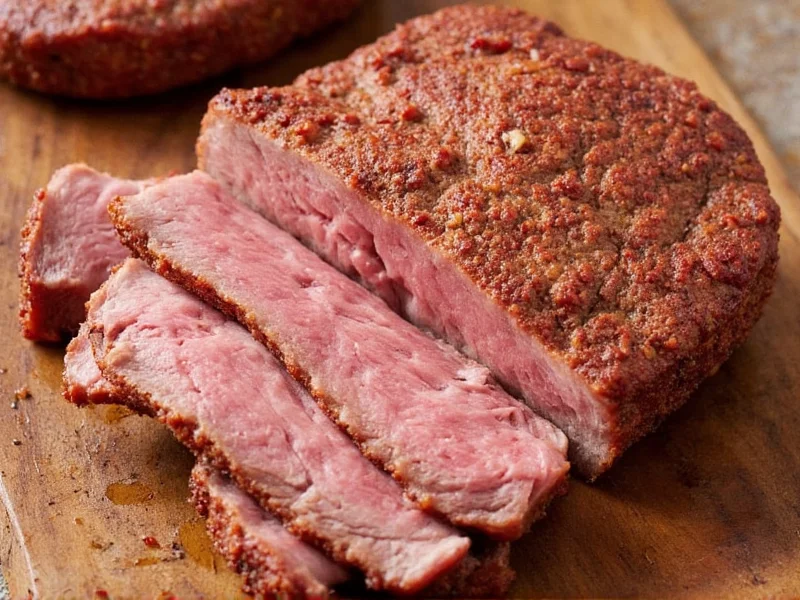Understanding the Science Behind Effective Pork Rubs
Creating the perfect dry rub isn't just about throwing spices together—it's a precise balance of flavor chemistry. Salt penetrates the meat's surface, enhancing moisture retention and seasoning beyond the surface layer. Sugar doesn't just add sweetness; it facilitates the Maillard reaction, creating that desirable caramelized crust during cooking. The combination of paprika and garlic powder forms the flavor backbone, while black pepper provides subtle heat that complements rather than dominates.
Historical Evolution of Pork Rub Formulations
Dry rub development for pork has undergone significant transformation, reflecting broader culinary trends and scientific understanding. Modern formulations balance tradition with food chemistry insights, as documented in culinary history research. This evolution demonstrates how regional practices gradually incorporated scientific principles for optimal flavor development.
| Era | Defining Characteristics | Key Developments |
|---|---|---|
| Pre-1950s | Preservation-focused, minimal ingredients | Salt-dominated blends primarily for curing; regional variations rare; black pepper added mainly for antimicrobial properties |
| 1950s-1970s | Emergence of regional styles | Brown sugar and paprika incorporated from Caribbean/Mexican influences; Memphis-style (sweet) and Texas-style (peppery) distinctions formalized |
| 1980s-2000s | Complexity and standardization | Mustard powder and cumin added for depth; competitive barbecue circuits established standardized ratios; cookbooks began publishing "signature" blends |
| 2000s-Present | Science-optimized formulations | Research on Maillard reaction kinetics informs sugar ratios; moisture retention studies guide salt concentrations; data-driven approaches replace anecdotal recipes |
This progression is extensively analyzed in Robert F. Moss's authoritative work "Barbecue: The History of an American Institution" (University of Alabama Press, 2010), which traces how cultural exchange and food science have shaped contemporary barbecue practices (Source).
Essential Components of a Superior Pork Rub
A high-quality pork dry rub requires seven core ingredients that work synergistically. Each component serves a specific purpose in the flavor development process:
| Ingredient | Primary Function | Flavor Contribution | Recommended Amount |
|---|---|---|---|
| Kosher salt | Moisture retention, flavor enhancement | Savory foundation | 4 parts |
| Brown sugar | Caramelization, balancing saltiness | Sweet, molasses notes | 2 parts |
| Sweet paprika | Color development, mild heat | Earthy, slightly sweet | 2 parts |
| Garlic powder | Aromatic base | Pungent, savory | 1 part |
| Onion powder | Flavor complexity | Sweet, umami | 1 part |
| Freshly ground black pepper | Subtle heat, aroma | Peppery, floral notes | 1 part |
| Mustard powder | Flavor enhancer, tenderizing | Sharp, tangy | 1 part |
Customizing Your Rub for Different Pork Cuts
While the foundational ratio works across most pork cuts, subtle adjustments maximize flavor for specific preparations. For pork shoulder destined for pulled pork, increase the brown sugar by 25% to complement the long smoking process. When preparing pork tenderloin, reduce salt by 20% since this lean cut absorbs seasoning more quickly. Baby back ribs benefit from an additional ½ teaspoon of cayenne per cup of rub for that perfect balance of sweet and heat.
Advanced Techniques for Rub Application
Proper application technique significantly impacts results. Always apply rub to dry meat surfaces—pat pork cuts thoroughly with paper towels before seasoning. For best results, apply the rub at least 12 hours before cooking, allowing time for flavor penetration. When applying, use a gentle pressing motion rather than rubbing, which can damage the meat's surface. For smoking applications, consider applying half the rub before cooking and the remainder during the final hour to maintain vibrant spice flavors.
Avoiding Common Dry Rub Mistakes
Many home cooks make critical errors that diminish their pork's flavor potential. Never apply wet rubs (those containing liquids) more than two hours before cooking, as they can begin to 'cook' the meat surface. Avoid using table salt in rubs—its fine crystals create uneven seasoning. Don't skip the resting period after cooking; allow pork to rest for 15-20 minutes after removal from heat to redistribute juices enhanced by the rub. Most importantly, resist the temptation to add excessive sugar—beyond a certain point, it inhibits proper bark formation on smoked meats.
Contextual Limitations and Environmental Considerations
While the foundational rub ratio serves as a reliable starting point, specific environmental and situational factors necessitate strategic adjustments to maintain optimal flavor development. Recognizing these boundaries prevents common pitfalls that even experienced cooks encounter.
Humidity Impact: In high-moisture environments (relative humidity >60%), dry rubs rapidly absorb atmospheric water, causing clumping and accelerating flavor compound degradation. Colorado State University Extension's research confirms that spice blends stored under these conditions lose 30-40% of volatile aromatic compounds within 30 days without proper moisture control. Their recommended mitigation—airtight glass containers with food-grade silica desiccants—preserves rub potency for 4-6 months even in humid climates (Colorado State University Extension, 2022).
Altitude Adjustments: At elevations exceeding 3,000 feet, reduced atmospheric pressure lowers water's boiling point, extending cooking times by 25-30%. This prolonged thermal exposure risks sugar caramelization turning into carbonization. Utah State University's extension data shows that reducing brown sugar by 15-20% in rub formulations prevents bitter burnt notes while maintaining desirable crust formation during high-altitude smoking (Utah State University Extension, 2023).
Cut-Specific Boundaries: The rub's interaction with meat varies significantly by cut anatomy. Fatty cuts like pork belly require a light oil coating before rub application to prevent seasoning displacement during rendering, while ultra-lean tenderloin absorbs salt more rapidly, necessitating reduced salt concentrations to avoid over-seasoning.
Storage and Shelf Life Considerations
Homemade dry rubs maintain peak flavor for 3-4 months when stored properly. Use airtight glass containers rather than plastic, which can retain moisture. Keep your rub away from direct light and heat sources—kitchen cabinets work better than spots near the stove. For extended storage, freeze your rub in ice cube trays, then transfer the frozen portions to freezer bags. This method preserves volatile flavor compounds for up to six months. Always label containers with the preparation date to track freshness.











 浙公网安备
33010002000092号
浙公网安备
33010002000092号 浙B2-20120091-4
浙B2-20120091-4